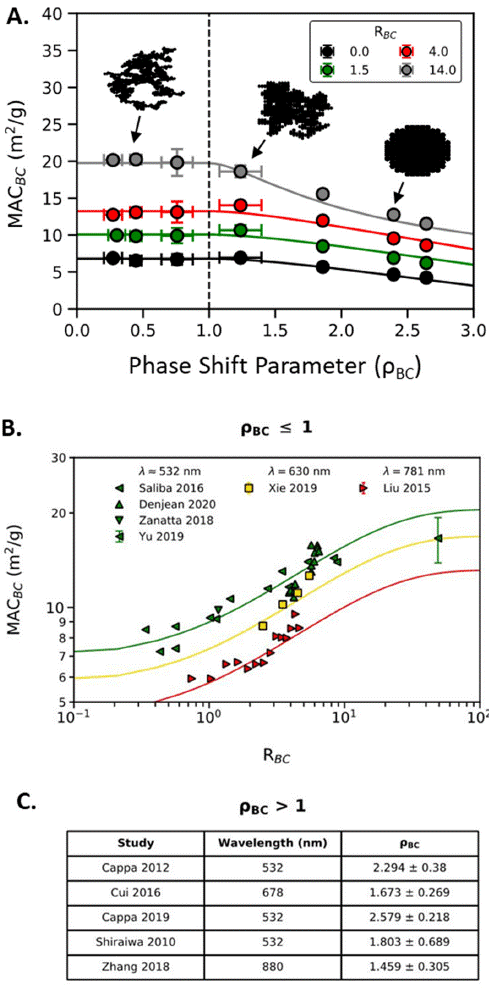Phase shift parameter controls radiative absorption enhancements by black carbon
Submitter
Chakrabarty, Rajan K
— Washington University in St. Louis
Beeler, Payton — Pacific Northwest National Laboratory
Area of Research
Radiation Processes
Journal Reference
Beeler P and R Chakrabarty 2022. "Constraining the particle-scale diversity of black carbon light absorption using a unified framework." Atmospheric Chemistry and Physics, 22(22), 10.5194/acp-22-14825-2022.
Science

(A) Figure 1. Mass absorption cross-sections (MACBC) of coated black carbon (BC) of different morphologies as a function of phase shift parameter (ρBC). For ρBC >1, little to no increase in MACBC with increasing BC coating mass (RBC) is observed, which is in line with field and laboratory observations (table C). (B) For ρBC ≤1, MACBC increases with increasing RBC. Scaling laws (solid lines) developed as part of this study are validated against observational data sets. From journal.
Black carbon (BC) aerosol dominates the absorption of incoming shortwave solar radiation in the Earth’s atmosphere, thereby strongly impacting regional and global climate. Understanding and parameterizing the influences of BC particle morphology and compositional heterogeneity on its light absorption is a fundamental problem in atmospheric sciences. We develop scaling laws using a single unifying parameter, the phase shift parameter, that effectively encompasses the large-scale diversity observed in BC-light interactions on a per-particle basis. These laws, besides providing process-based insights, help to reconcile the disparities between laboratory and field observations, and model predictions of differing magnitudes of BC light absorption.
Impact
This study addresses one of the grand challenges in atmospheric climate science, which is quantitative estimation of enhancement in light absorption by atmospheric BC aerosol for accurate representation in climate models. BC in the atmosphere is distributed among complex particles of varied size, shape, and chemical composition. Field and laboratory observations carried out worldwide have shown that BC, when mixed with other aerosol components, absorbs more strongly than pure, uncoated BC; however, some ambient observations suggest more variable and weaker absorption enhancement. The scientific understanding of the factors that drive the large variability in BC light absorption on the per-particle scale remains inadequate and contributes to the large uncertainty in BC climate forcing. The situation has challenged the atmospheric modeling community to better represent the full complexity and diversity of BC-containing particle composition and internal morphology, which is extremely expensive computationally.
Summary
We took a two-pronged approach to develop a simple yet rigorous unified framework for parameterizing the effects of particle size, morphology, and compositional heterogeneity on BC light absorption. The first approach involved reducing the aforementioned multivariate space to a single parameter, the phase shift parameter, which captures causal relationships between BC’s physico-chemical properties and corresponding light absorption. Using this parameter, we developed universal scaling laws for wavelength-dependent BC light absorption as a function of size, morphology, and mixing state. We validated these laws against observational data sets from 11 field and laboratory studies conducted worldwide that investigated light absorption enhancement. A highlight finding from this study is drawing the attention of the community to BC morphology playing an equal, if not more important, role in modulating light absorption. Most previous studies focused entirely on the compositional heterogeneity of BC to explain the variation in light absorption.
Finally, we provide a physics-based explanation for why weaker absorption enhancements were observed in certain regional BC populations compared to laboratory results of similar mixing mass. For practical applications, we packaged our model framework into open-source Python software that allows researchers to use our results to estimate absorption of BC aerosols based on their size, morphology, and mixing state. Thus, this framework provides a path forward for improved model parameterization of BC in a computationally inexpensive manner.
Keep up with the Atmospheric Observer
Updates on ARM news, events, and opportunities delivered to your inbox
ARM User Profile
ARM welcomes users from all institutions and nations. A free ARM user account is needed to access ARM data.


















